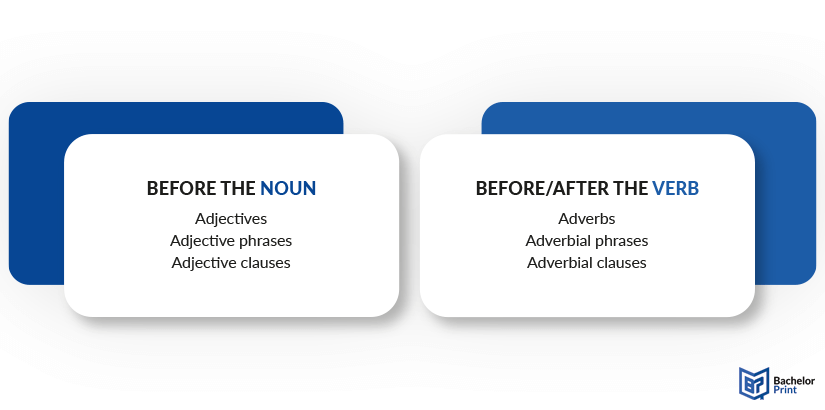
Modifiers are potent tools in academic writing, enhancing your work with detail and specificity. By understanding and applying the language rules associated with these words, phrases, or clauses that function as adjectives or adverbs, you can modify and refine the meaning of your sentences. Moreover, effective use of modifiers can help your arguments stand out, providing a clear pathway for readers to grasp complex academic concepts. Our guide will help you master the use of modifiers.
Definition: Modifiers
Modifiers can be words, phrases, or clauses that provide description and detail to other components in a sentence structure, thereby enhancing and clarifying the meaning. Overall, they modify nouns, pronouns, verbs, adjectives, or adverbs, giving more specific information. Apart from describing qualities, they can also specify quantity, provide additional context, or clarify actions without being grammatically necessary.
Structure
Understanding the structure of modifiers and modifier placement helps in constructing clear and precise sentences. Here, we will outline the structure of different types of modifiers, including single-word modifiers, phrases, and clauses. The following shows the overall structure for adjective and adverbial modifiers.
Single-word modifiers
Adjective + Noun/Pronoun
Adverb + Verb/Adjective/Adverb
Phrasal modifiers
Preposition/Adjective + Noun/Pronoun + Modifier (optional)
Verb + Modifier (optional)
Clause modifiers
Relative Pronoun + Subject + Verb = Modifier (optional)
Subordinating Conjunction + Subject + Verb + Modifier (optional)
Modifying adjectives
Modifiers can be adjective words, adjective phrases, or adjective clauses that describe or provide further details about nouns or pronouns. They help to specify which one, what kind, or how many of the nouns/pronouns are being referred to. Here is a general overview of how adjectives as modifiers work in their various shapes, with examples of modifier clauses and phrases.
When a modifier adds more information to a noun or pronoun, it acts as an adjective.
Adjective phrases represent a group of words that collectively act as an adjective, providing additional details about a noun or pronoun.
Adjective clauses are dependent clauses that function as adjectives, providing more details about someone/something. They often begin with a relative pronoun like who, whom, that, or which.
Modifiers as adjectives can be in the form of a single-word modifier or compound adjectives. Compound adjectives are constructed with two or more words, functioning as a single adjective. Typically, they are joined by hyphens to prevent confusion and clarify that the words function together as a single unit.
Types of modifier adjectives
The function of adjectives is to modify nouns or pronouns by adding information about their characteristics, quantity, or quality. In relation to this, various types of adjectives answer questions like “which one?”, “what kind?”, and “how many?”.
…describe the qualities or states of being of nouns.
…indicate the quantity of nouns.
…point out specific nouns.
…imply ownership or possession.
…used in questions to modify nouns.
…indicate comparisons between nouns.
The main categories above (descriptive, quantitative, demonstrative, etc.) describe the type or specific function of the adjective. These additional categories focus more on placement and function within sentences rather than introducing entirely new adjective types.
Indefinite adjectives are a sort of modifier that provide non-specific information about the nouns they modify. They do not refer to a specific item or quantity, but rather give a general sense or idea about the amount or nature of the noun. Their main functions are to quantify nouns, generalize, and indicate unspecified amounts. Here is a list of common indefinite adjectives in context.
A predicate adjective refers to a sort of modifier that provides more information about the subject of a complete sentence. They do not precede the nouns they describe like typical adjectives but follow a linking verb and are part of the predicate in the sentence. The most common linking verbs are “to be,” “to seem,” “to become,” “to feel,” “to look,” “to sound,” “to taste,” and “to appear.”
Prepositional-phrase modifiers are groups of words starting with a preposition and ending with a noun or pronoun. When acting as adjectives, they clarify nouns or pronouns in a sentence.
Modifying adverbs
Adverbs are a sort of modifier that provides additional information about verbs, adjectives, other adverbs, or entire sentences. They can describe the manner, time, place, frequency, degree, or reason for an action or condition. Here is a general overview of how adverbs as modifiers work in their various shapes, with examples of modifier phrases and clauses.
A single-word adverb can significantly enhance a sentence by modifying verbs, adjectives, other adverbs, or sentences.
Adverbial phrases are a group of words that function as adverbs, enhancing the meaning of a sentence.
Adverbial clauses are dependent clauses, functioning as adverbs. They are generally introduced by subordinating conjunctions such as “when,” “wherever,” “as if,” “because,” “if,” “so,” “that,” and “although.”
Adverbs as prepositional phrase modifiers
Prepositional phrase modifiers can also function as adverbs. A prepositional phrase consists of a preposition and its object, along with any modifier of the object. When the prepositional phrase modifies a verb, adjective, or adverb, providing information about time, place, manner, reason, or degree, the prepositional phrase modifier acts as an adverb.
Modifier placement
Proper placement of modifiers is crucial for clear and precise communication. Incorrect placement can lead to confusion or misinterpretation of the intended meaning. Here, we’ll explore the correct placement of various types of modifiers. Single-word modifiers have specific placements in sentences, depending on whether they are adjectives or adverbs.
Examples
Adjectives are typically placed before the noun/pronoun they modify, while adverbs can be placed before or after the verbs, adjectives, or other adverbs they modify. The key is to pay attention to what is being modified.
Examples
Phrasal modifiers also follow distinct rules in terms of their placement. Adjective phrases directly follow the noun or pronoun they modify, while adverbial phrases can be placed before or after the verb, adjective, or adverb they modify.
Examples
For clause modifiers, adjective clauses are primarily placed immediately after the noun/pronoun they modify, whereas adverbial clauses can be placed at the beginning, middle, or end of the sentence, depending on the emphasis or clarity.

Examples and tips
The following table represents examples of incorrect placements and their corrected versions for a better understanding.
There are a few tips to keep in mind to place modifiers correctly.
- Identify the word that the modifier is intended to modify.
- Position the modifier as close as possible to the word it modifies.
- Ensure that the modifier unambiguously modifies the word.
- Read the sentence aloud to detect awkward or unclear placements.
Misplaced modifiers
Misplaced modifiers are words, phrases, or clauses that are improperly separated from the word they describe. Due to this separation, this sort of modifier appears to modify the wrong word or phrase, leading to a sentence with a different meaning.
The first sentence implies that she barely passed each exam but made it, while the second sentence says that she failed the majority of her exams.
Here, the misplaced modifier in the first sentence implies that the children are on paper plates rather than the sandwiches, as the second sentence states.
In this case, the first sentence expresses that the professor told their class on Monday that there will be a test, instead of her announcing that the test takes place on Monday.
Dangling modifiers
Dangling modifiers are words, phrases, or clauses that are not clearly or logically related to the word or phrases they modify. As this sort of modifier does not explicitly refer to the correct part in a sentence, it creates confusion. Dangling modifiers often occur at the initial position of a sentence, but can appear anywhere.
In the examples, it is evident that the sentences do not feature subjects to relate to the modifier at the beginning of the sentence.
Squinting modifier
Another type of modifier is the squinting modifier. It’s a type of ambiguous modifier that can modify either the word or phrase before or after it. Thereby, it is not clear which part of the sentence is modified. Squinting modifiers are often adverbs placed between two sentence components that can logically be modified. Thus, the modifier placement plays an important role in correcting them.
Examples
In these examples, it is crucial to reposition, rephrase, or replace the modifiers so that they clearly modify only one word or phrase.
Test yourself!
Practice sheet
Identify and correct the misplaced modifiers in the following sentences. Rewrite each sentence to place the modifier next to the word it is intended to modify, ensuring clarity. You can find the solutions in the second tab.
- The dog was chasing the squirrel wearing a red collar.
- She almost watched the entire movie.
- The teacher said during the lecture students could ask questions.
- He saw a bicycle on his way to the store that was broken.
- I only have ten dollars to spend on groceries.
- The man walked toward the car carrying a briefcase.
- He nearly drove his friends to the airport every weekend.
- The painting was sold to the woman with the golden frame.
- We watched the sunset sitting on the porch.
- She served a steak to the guests that was overcooked.
- The dog wearing a red collar was chasing the squirrel.
- She watched almost the entire movie.
- During the lecture, the teacher said students could ask questions.
- On his way to the store, he saw a broken bicycle.
- I have only ten dollars to spend on groceries.
- Carrying a briefcase, the man walked toward the car.
- He drove his friends to the airport nearly every weekend.
- The painting with the golden frame was sold to the woman.
- Sitting on the porch, we watched the sunset.
- She served an overcooked steak to the guests.
FAQs
Here are a few examples of using modifiers in context:
- The red apple tastes sweet.
- She sings beautifully.
- He ran with great speed.
Here are five common types of modifiers:
- Adjectives
- Adjective phrases
- Adverbs
- Adverbial phrases
- Clausal modifiers
Modifiers are words, phrases, or clauses that provide additional information about other words in a sentence, making the meaning clearer or more specific. They describe, clarify, or give more detail about a noun, pronoun, verb, adjective, or adverb.
You can identify modifiers by looking for descriptive words, phrases, or clauses that add more detail, or by checking if the word or phrase answers specific questions like, “which one?”, “what kind?”, “how many?”, “how?”, “when?”, “where?”, “to what extent?”.
Misplaced modifiers are words, phrases, or clauses that are not placed near the word they are intended to modify, causing confusion or a change in the intended meaning of the sentence.
Printing Your Thesis With BachelorPrint
- High-quality bindings with customizable embossing
- 3D live preview to check your work before ordering
- Free express delivery
Configure your binding now!
